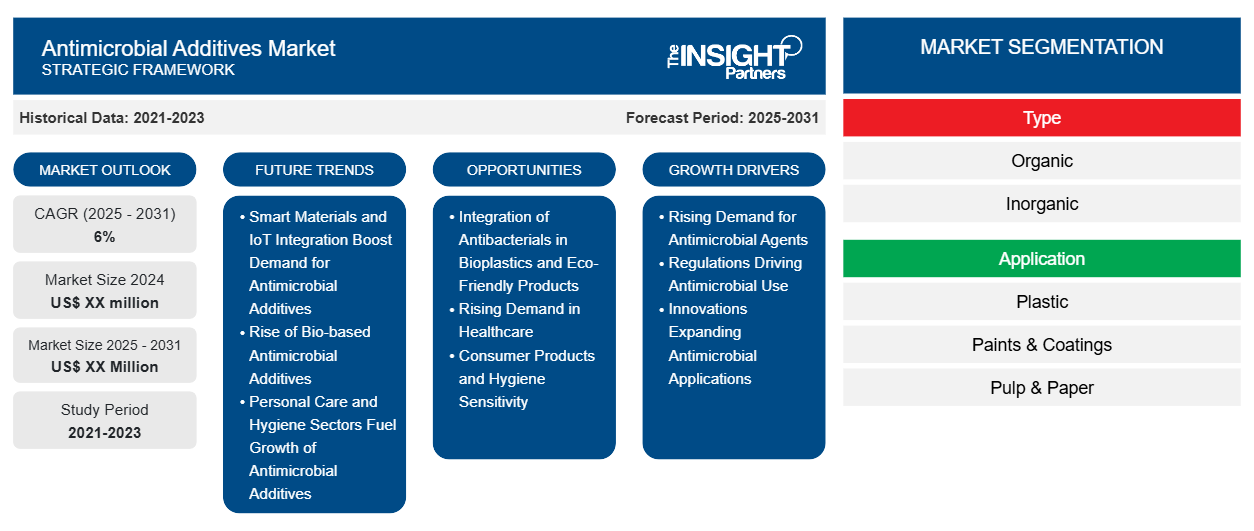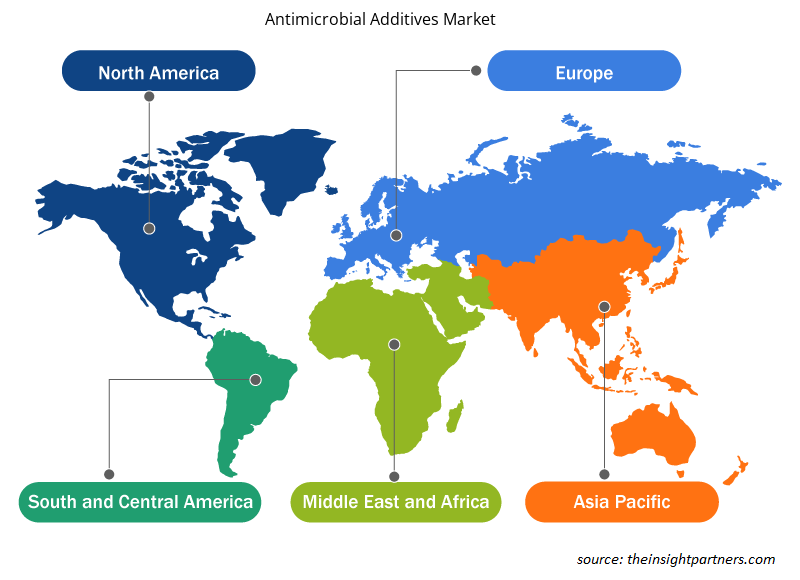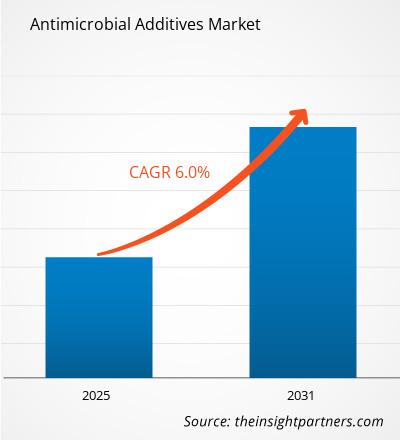The Antimicrobial Additives Market is expected to register a CAGR of 6% from 2025 to 2031, with a market size expanding from US$ XX million in 2024 to US$ XX Million by 2031.
The report is segmented by Type (Organic, Inorganic). The global analysis is further broken-down at regional level and major countries. The report further presents analysis based on Application (Plastic, Paints & Coatings, Pulp & Paper, Others). The global analysis is further broken-down at regional level and major countries. The market size and forecast at global, regional, and country levels for all the key market segments are covered under the scope. The report offers the value in USD for the above analysis and segments. The report provides key statistics on the market status of the key market players and offers market trends and opportunities.
Purpose of the Report
The report Antimicrobial Additives Market by The Insight Partners aims to describe the present landscape and future growth, top driving factors, challenges, and opportunities. This will provide insights to various business stakeholders, such as:
- Technology Providers/Manufacturers: To understand the evolving market dynamics and know the potential growth opportunities, enabling them to make informed strategic decisions.
- Investors: To conduct a comprehensive trend analysis regarding the market growth rate, market financial projections, and opportunities that exist across the value chain.
- Regulatory bodies: To regulate policies and police activities in the market with the aim of minimizing abuse, preserving investor trust and confidence, and upholding the integrity and stability of the market.
Antimicrobial Additives Market SegmentationType - Organic
- Inorganic
Application - Plastic
- Paints & Coatings
- Pulp & Paper
- Others
End-Use Industry - Healthcare
- Packaging
- Food & Beverage
- Construction
- Automotive
- Others
Geography - North America
- Europe
- Asia-Pacific
- South and Central America
- Middle East and Africa
- Organic
- Inorganic
Application - Plastic
- Paints & Coatings
- Pulp & Paper
- Others
End-Use Industry - Healthcare
- Packaging
- Food & Beverage
- Construction
- Automotive
- Others
Geography - North America
- Europe
- Asia-Pacific
- South and Central America
- Middle East and Africa
- Healthcare
- Packaging
- Food & Beverage
- Construction
- Automotive
- Others
Geography - North America
- Europe
- Asia-Pacific
- South and Central America
- Middle East and Africa
Customize This Report To Suit Your Requirement
You will get customization on any report - free of charge - including parts of this report, or country-level analysis, Excel Data pack, as well as avail great offers and discounts for start-ups & universities
Antimicrobial Additives Market: Strategic Insights

- Get Top Key Market Trends of this report.This FREE sample will include data analysis, ranging from market trends to estimates and forecasts.
Antimicrobial Additives Market Growth Drivers- Rising Demand for Antimicrobial Agents: The modern population's use of antimicrobial agents has been noticeably helped by the rise in the hysteria concerning hygiene and health, particularly in this era when the outbreak of the COVID-19 pandemic is still fresh in the minds of everyone. More and more, these additives are finding their way into everyday goods like apparel, food and beverage containers, medical apparatus, and electrical devices in order to control the growth and spread of microorganisms thereby increasing shelf life and safety of the products.
- Regulations Driving Antimicrobial Use: There are also improving regulations globally for the safety of products with specific concern on medical and food packaging safety. Thus, other manufacturers are forced to use antimicrobial ingredients in their products in order to comply with the hygiene and safety requirements. This is especially so with sectors such as healthcare and food packaging where the consumers have to be protected from harmful microorganisms.
- Innovations Expanding Antimicrobial Applications: The manufacturing of newer and better antimicrobial additives which have a much more durable activity profiles has opened the doors to their usage in more fields like construction. This has been driven by the enhanced activity of controlling or preventing the growth of microorganisms, the use of new technologies such as nano-technology, and the growth of these markets in industries such as textiles, buildings and vehicles manufacturing.
Antimicrobial Additives Market Future Trends- Smart Materials and IoT Integration Boost Demand for Antimicrobial Additives: With the rise of smart materials and their communicative technology-the Antimicrobial additive are being used more often in products like the wearables, the smart packaging, and the medical devices. These additives are likely to extend beyond just the antimicrobial feature, and provide capabilities such as monitoring the levels of hygiene in real time thereby improving the functionalities of the IoT devices and their safety.
- Rise of Bio-based Antimicrobial Additives: Focus has shifted towards the use of more natural sources of materials such as the plant extracts and essential oils , there is now a notable increase in the use of bio based antimicrobial additives due to the pressures from the market and the authorities to provide environmentally friendly alternatives. In addition to being friendly to the environment, these bio-based additives help in reducing waste associated with the traditional chemical based additives as they are designed to decompose, hence complementing the current tendency towards using environmentally sustainable components.
- Personal Care and Hygiene Sectors Fuel Growth of Antimicrobial Additives: The markets for personal care and hygiene are forecasted to emerge as strong growth drivers for antimicrobial additives in the forecast period. As consumers look for products with extra safety for the bacteria and the viruses, the use of antimicrobial additives in such products as cosmetics, skin care products and even sanitizers will keep increasing. This will be propelled by the demand of the consumers and the need to curb diseases mostly after the outbreak of covid 19.
Antimicrobial Additives Market Opportunities- Integration of Antibacterials in Bioplastics and Eco-Friendly Products: Due to the growing concern over environmental effects, there is high potential for the application of antibacterials in bioplastics and other eco-friendly shielding agents. The use of biomedical plastic materials in manufacturing products such as packaging and textiles, which are obviously moving towards sustainability, will relentlessly affect the use of antimicrobial additives that can be blended into those green materials. This could especially target the regions that are aware of, if not fully practising, green principles in their activities.
- Rising Demand in Healthcare: Healthcare presents a notable market for antimicrobial additives due to the increasing need to protect medical devices and to reduce hospital acquired infections. More and more patient and health provider’s safety concerns will come antimicrobial additives to be used inside the products and appliances like catheters, implants, surgical instruments which will further widen the market within the medical arena.
- Consumer Products and Hygiene Sensitivity: Antimicrobial agents are already present in some consumer-focused products such as kitchen and electronic utensils and garments. With more hygiene sensitive products being called for by customers, antimicrobial substances will also be used for producing products such as the toothbrushes, phone and bed covers among others. Increasing consumer demand for hygiene coupled with increased understanding of the need for antimicrobial protection will ensure availability of abundant opportunities for growth.
- Smart Materials and IoT Integration Boost Demand for Antimicrobial Additives: With the rise of smart materials and their communicative technology-the Antimicrobial additive are being used more often in products like the wearables, the smart packaging, and the medical devices. These additives are likely to extend beyond just the antimicrobial feature, and provide capabilities such as monitoring the levels of hygiene in real time thereby improving the functionalities of the IoT devices and their safety.
- Rise of Bio-based Antimicrobial Additives: Focus has shifted towards the use of more natural sources of materials such as the plant extracts and essential oils , there is now a notable increase in the use of bio based antimicrobial additives due to the pressures from the market and the authorities to provide environmentally friendly alternatives. In addition to being friendly to the environment, these bio-based additives help in reducing waste associated with the traditional chemical based additives as they are designed to decompose, hence complementing the current tendency towards using environmentally sustainable components.
- Personal Care and Hygiene Sectors Fuel Growth of Antimicrobial Additives: The markets for personal care and hygiene are forecasted to emerge as strong growth drivers for antimicrobial additives in the forecast period. As consumers look for products with extra safety for the bacteria and the viruses, the use of antimicrobial additives in such products as cosmetics, skin care products and even sanitizers will keep increasing. This will be propelled by the demand of the consumers and the need to curb diseases mostly after the outbreak of covid 19.
Antimicrobial Additives Market Opportunities- Integration of Antibacterials in Bioplastics and Eco-Friendly Products: Due to the growing concern over environmental effects, there is high potential for the application of antibacterials in bioplastics and other eco-friendly shielding agents. The use of biomedical plastic materials in manufacturing products such as packaging and textiles, which are obviously moving towards sustainability, will relentlessly affect the use of antimicrobial additives that can be blended into those green materials. This could especially target the regions that are aware of, if not fully practising, green principles in their activities.
- Rising Demand in Healthcare: Healthcare presents a notable market for antimicrobial additives due to the increasing need to protect medical devices and to reduce hospital acquired infections. More and more patient and health provider’s safety concerns will come antimicrobial additives to be used inside the products and appliances like catheters, implants, surgical instruments which will further widen the market within the medical arena.
- Consumer Products and Hygiene Sensitivity: Antimicrobial agents are already present in some consumer-focused products such as kitchen and electronic utensils and garments. With more hygiene sensitive products being called for by customers, antimicrobial substances will also be used for producing products such as the toothbrushes, phone and bed covers among others. Increasing consumer demand for hygiene coupled with increased understanding of the need for antimicrobial protection will ensure availability of abundant opportunities for growth.
Antimicrobial Additives Market Regional Insights
The regional trends and factors influencing the Antimicrobial Additives Market throughout the forecast period have been thoroughly explained by the analysts at Insight Partners. This section also discusses Antimicrobial Additives Market segments and geography across North America, Europe, Asia Pacific, Middle East and Africa, and South and Central America.

- Get the Regional Specific Data for Antimicrobial Additives Market
Antimicrobial Additives Market Report Scope
| Report Attribute | Details |
|---|---|
| Market size in 2024 | US$ XX million |
| Market Size by 2031 | US$ XX Million |
| Global CAGR (2025 - 2031) | 6% |
| Historical Data | 2021-2023 |
| Forecast period | 2025-2031 |
| Segments Covered |
By Type
|
| Regions and Countries Covered | North America
|
| Market leaders and key company profiles |
Antimicrobial Additives Market Players Density: Understanding Its Impact on Business Dynamics
The Antimicrobial Additives Market market is growing rapidly, driven by increasing end-user demand due to factors such as evolving consumer preferences, technological advancements, and greater awareness of the product's benefits. As demand rises, businesses are expanding their offerings, innovating to meet consumer needs, and capitalizing on emerging trends, which further fuels market growth.
Market players density refers to the distribution of firms or companies operating within a particular market or industry. It indicates how many competitors (market players) are present in a given market space relative to its size or total market value.
Major Companies operating in the Antimicrobial Additives Market are:
- BASF SE
- Nutrition & Biosciences
- Microban International
- LyondellBasell Industries Holdings B.V.
- Avient
Disclaimer: The companies listed above are not ranked in any particular order.

- Get the Antimicrobial Additives Market top key players overview
Key Selling Points- Comprehensive Coverage: The report comprehensively covers the analysis of products, services, types, and end users of the Antimicrobial Additives Market, providing a holistic landscape.
- Expert Analysis: The report is compiled based on the in-depth understanding of industry experts and analysts.
- Up-to-date Information: The report assures business relevance due to its coverage of recent information and data trends.
- Customization Options: This report can be customized to cater to specific client requirements and suit the business strategies aptly.
The research report on the Antimicrobial Additives Market can, therefore, help spearhead the trail of decoding and understanding the industry scenario and growth prospects. Although there can be a few valid concerns, the overall benefits of this report tend to outweigh the disadvantages.
Frequently Asked Questions
What is the furture trend for antimicrobial additives market?
Integration with smart materials and IoT devices is expected to be the key market trends
Which is the fastest growing segment based on type?
Based on type, the organic segment is expected to witness the fastest growth during the forecast period
Based on geography, which region held the largest share of the antimicrobial additives market?
Based on geography, Asia Pacific held the largest share of the antimicrobial additives market due to the well-established manufacturing and growing healthcare industry across the region, coupled with continuous growth and development
What are the driving factors impacting the antimicrobial additives market?
Growing awareness of hygiene and health concerns is driving the market growth
What are the key players operating in the antimicrobial additives market?
BASF SE
; Lonza Group
; Clariant International Ltd.
; Microban International
; DSM
; BioCote
; Troton
; Troy Corporation
; Rust-Oleum
; Sciessent
; AkzoNobel
; Addmaster (UK) Ltd.
; SABIC
; Kraton Polymers
; Ferro Corporation
What is the expected CAGR of the Antimicrobial Additives Market?
The Antimicrobial Additives Market is estimated to witness a CAGR of 6% from 2023 to 2031
- Historical Analysis (2 Years), Base Year, Forecast (7 Years) with CAGR
- PEST and SWOT Analysis
- Market Size Value / Volume - Global, Regional, Country
- Industry and Competitive Landscape
- Excel Dataset
Testimonials
Reason to Buy
- Informed Decision-Making
- Understanding Market Dynamics
- Competitive Analysis
- Identifying Emerging Markets
- Customer Insights
- Market Forecasts
- Risk Mitigation
- Boosting Operational Efficiency
- Strategic Planning
- Investment Justification
- Tracking Industry Innovations
- Aligning with Regulatory Trends
Yes! We provide a free sample of the report, which includes Report Scope (Table of Contents), report structure, and selected insights to help you assess the value of the full report. Please click on the "Download Sample" button or contact us to receive your copy.
Absolutely — analyst assistance is part of the package. You can connect with our analyst post-purchase to clarify report insights, methodology or discuss how the findings apply to your business needs.
Once your order is successfully placed, you will receive a confirmation email along with your invoice.
• For published reports: You’ll receive access to the report within 4–6 working hours via a secured email sent to your email.
• For upcoming reports: Your order will be recorded as a pre-booking. Our team will share the estimated release date and keep you informed of any updates. As soon as the report is published, it will be delivered to your registered email.
We offer customization options to align the report with your specific objectives. Whether you need deeper insights into a particular region, industry segment, competitor analysis, or data cut, our research team can tailor the report accordingly. Please share your requirements with us, and we’ll be happy to provide a customized proposal or scope.
The report is available in either PDF format or as an Excel dataset, depending on the license you choose.
The PDF version provides the full analysis and visuals in a ready-to-read format. The Excel dataset includes all underlying data tables for easy manipulation and further analysis.
Please review the license options at checkout or contact us to confirm which formats are included with your purchase.
Our payment process is fully secure and PCI-DSS compliant.
We use trusted and encrypted payment gateways to ensure that all transactions are protected with industry-standard SSL encryption. Your payment details are never stored on our servers and are handled securely by certified third-party processors.
You can make your purchase with confidence, knowing your personal and financial information is safe with us.
Yes, we do offer special pricing for bulk purchases.
If you're interested in purchasing multiple reports, we’re happy to provide a customized bundle offer or volume-based discount tailored to your needs. Please contact our sales team with the list of reports you’re considering, and we’ll share a personalized quote.
Yes, absolutely.
Our team is available to help you make an informed decision. Whether you have questions about the report’s scope, methodology, customization options, or which license suits you best, we’re here to assist. Please reach out to us at sales@theinsightpartners.com, and one of our representatives will get in touch promptly.
Yes, a billing invoice will be automatically generated and sent to your registered email upon successful completion of your purchase.
If you need the invoice in a specific format or require additional details (such as company name, GST, or VAT information), feel free to contact us, and we’ll be happy to assist.
Yes, certainly.
If you encounter any difficulties accessing or receiving your report, our support team is ready to assist you. Simply reach out to us via email or live chat with your order information, and we’ll ensure the issue is resolved quickly so you can access your report without interruption.















The List of Companies
- BASF SE
- Nutrition & Biosciences
- Microban International
- LyondellBasell Industries Holdings B.V.
- Avient
- BioCote Limited
- Novapura AG
- Clariant
- Americhem
- Blendcolours






 Get Free Sample For
Get Free Sample For